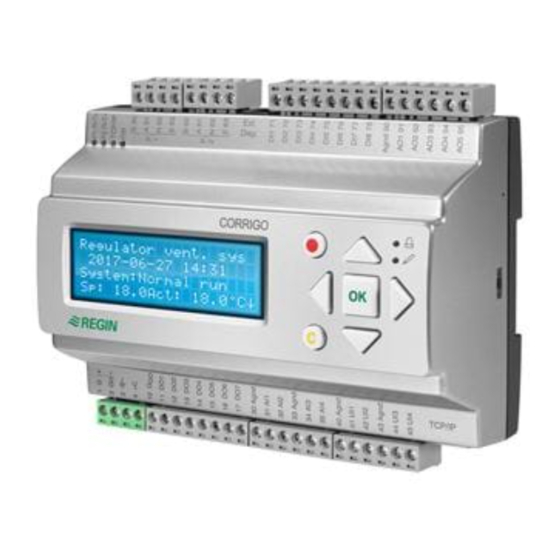
Table of Contents
Advertisement
Quick Links
Advertisement
Table of Contents

Summarization of Contents
About the manual
More information
Links to related manuals and Regin's website for additional product details.
About Corrigo E
Hardware Overview and Model Details
Details hardware specifications, model variations, and communication ports of the Corrigo E series.
Technical Data
Comprehensive list of technical specifications including environmental, electrical, and physical properties.
Installation and wiring
Installation and General Wiring
Guidelines for physical installation and basic wiring requirements for the Corrigo E controller.
Input/Output Lists and Configuration
Details available input/output signals and their configuration options.
Commissioning
Commissioning Procedures
Step-by-step guide for configuring the Corrigo E using the front panel or E tool.
Commissioning Options and References
Outlines alternative commissioning methods and refers to relevant manual chapters.
Functional description
Temperature Control Functions
Explains various modes of temperature control for ventilation applications.
Heater and Heat Exchanger Control
Details control for different heater types and heat exchanger functions.
Fan Control Modes
Describes single-speed, two-speed, and variable speed fan control methods.
Humidity and Other Controls
Details humidity control, extra circuits, and change-over functions.
Alarms
Covers alarm handling, priorities, and stop functions for system monitoring.
Starting and stopping the unit
Unit Start/Stop Conditions and Sequences
Lists conditions for unit startup and outlines the sequential operation steps.
Display, LEDs and buttons
User Interface Elements
Describes the unit's display, indicator LEDs, and control buttons.
Navigating the Menu System
Provides instructions on how to move through and interact with the unit's menus.
Access rights
User Log On and Log Off
Explains how to access different user levels and log off the system.
Password Management Procedures
Details how to change passwords and manage automatic logoff settings.
Running mode
Running Mode and System Status
Displays current running mode, selected functions, and operational status.
Temperature
Temperature Control Setpoints and Modes
Configuration of setpoints and selection of various temperature control modes.
Support Control and Frost Protection
Settings for support control heating/cooling and frost protection.
Air control
Pressure, Flow, and CO2 Control
Configuration of pressure, flow, and CO2-based air control strategies.
Humidity control
Humidity Sensor Configuration
Details the setup and use of humidity sensors for control.
Time settings
Time, Date, and Scheduling
Setting time, date, and configuring daily schedules for unit operation.
Timer Outputs and Holidays
Configuring timer outputs and setting up holiday periods for schedules.
Manual / Auto
Manual Control of Unit Functions
Allows manual override of outputs and control functions for testing or diagnostics.
Settings
Control Parameter Configuration
Adjusting parameters like P-band and I-time for various control loops.
Alarm Limit and Delay Settings
Configuring alarm thresholds, priorities, and delay times.
Settings Management
Options for saving and restoring controller settings.
Configuration
Input/Output Configuration
Binding physical inputs and outputs to control functions.
Control Function and Fan Settings
Selecting control functions and configuring fan operation modes.
Chiller, Pump, and Fire Controls
Configuring chiller, pump operations, and fire damper functions.
Alarm and Communication Settings
Setting up alarms and configuring communication protocols like Modbus.
System and Expansion Settings
Managing system-level settings, language, and expansion units.
Expansion model
Port Usage and Wiring
Details regarding port 1 and port 2 usage for communication and expansion.
Other functions
Alarm Handling and System Information
Managing alarms, viewing revision numbers, and free text display.
Start-up Wizard and Battery
Guides initial setup and describes battery replacement procedures.




Need help?
Do you have a question about the Corrigo E28 Series and is the answer not in the manual?
Questions and answers